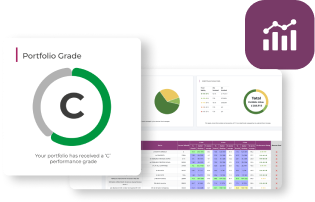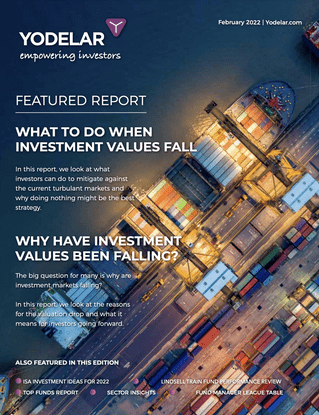-
Many portfolios contain multiple funds that appear different but share near-identical holdings, leading to hidden duplication, concentrated exposure, and unnecessary costs.
-
Investors often rely too heavily on recent performance without understanding the drivers behind it, resulting in portfolios that are poorly prepared for changing market conditions.
-
Without regular rebalancing, portfolios can drift significantly from their intended structure, increasing risk and reducing long-term efficiency.
-
Diversification is frequently misunderstood - holding more funds doesn’t always reduce risk if they target the same styles or regions and lack genuine variation in strategy.
Building a portfolio that grows steadily over time takes more than simply picking good funds. It requires structure, discipline, and an understanding of how each part of the portfolio works together. But even experienced investors can make avoidable mistakes - decisions that, while well-intended, quietly reduce long-term returns.
Through our analysis of thousands of investor portfolios, we’ve identified five issues that frequently undermine performance. These mistakes are rarely deliberate. They often stem from legacy advice, limited oversight, or a lack of visibility into how funds interact. But their impact can be significant - creating inefficiencies, skewing risk, and limiting the portfolio’s ability to adapt.
This article outlines the five most common portfolio mistakes we see and explains why each one matters. Most importantly, it highlights how investors can address them - improving structure, reducing risk, and giving their portfolio a better chance of delivering on its long-term objectives.
1. Duplication of Funds
One of the most common inefficiencies we see is fund duplication. This occurs when investors hold multiple funds that fall within the same Investment Association sector and follow similar strategies, resulting in overlapping holdings and concentrated exposure.
In many cases, portfolios will include several funds classified within the same region - such as Global, UK All Companies or North America. While the fund names and providers may differ, the underlying holdings often look remarkably similar. In some instances, as much as 60% to 70% of holdings across different funds are made up of the same top companies, meaning investors are inadvertently concentrating their portfolio exposure.
This duplication weakens the effectiveness of diversification. Rather than spreading risk across different areas of the market, the portfolio becomes increasingly reliant on a narrow group of companies or sectors. If these areas underperform, the negative impact can ripple across the entire portfolio.
There’s also a cost dimension. Investors often pay full active management fees across multiple funds that provide near-identical exposure. Without adding any genuine diversification, this simply compounds costs and erodes long-term returns. In many cases, duplication also means investors are paying twice - or more - for access to the same underlying assets.
Duplication is rarely obvious. It often goes unnoticed because funds have different names, branding, or investment messages. But without clear visibility into how each fund behaves - and what it holds - investors can easily end up paying multiple times for the same strategy. A clear, top-down portfolio review is essential for uncovering this kind of structural inefficiency.
2. Overreliance on Past Performance
Strong past performance can be a sign of quality. When reviewed properly, it helps identify funds and fund managers that have delivered consistent results across different market environments. But too often, investors build portfolios around recent top performers without examining the underlying drivers of those results.
Many of the portfolios we assess contain a cluster of funds that have recently performed well but do so by leaning into similar themes. For example, the past decade has seen large-cap US technology stocks dominate returns. As a result, many of the top performers over recent years have been funds with concentrated exposure to that trend. When combined in a portfolio, these funds may seem diverse in name but are highly correlated in risk.
Using performance data without context can lead to false confidence. A fund that delivered strong returns in a low-interest-rate environment may not adapt well to rising inflation, tighter monetary policy, or a shift towards value and income. If its past performance hasn’t been tested across multiple cycles, its future reliability may be limited.
It’s also common to see performance-chasing behaviours - where portfolios are regularly adjusted to include recent winners, often too late. This reactive approach results in buying high and missing the initial growth phase that made the fund look appealing in the first place.
Past performance is valuable - when used as one part of a broader assessment. It should be analysed alongside volatility, consistency, and the macroeconomic conditions in which it was achieved. Relying on it in isolation can result in portfolios that are overexposed, narrow in focus, and poorly equipped to deal with change.
3. Lack of Active Rebalancing
No portfolio stays in balance by itself. As markets evolve, some regions, sectors, or asset classes will rise in value while others lag - causing the portfolio’s weightings to shift and its risk profile to change.
This natural movement is often referred to as portfolio drift. But what many investors fail to recognise is just how quickly and significantly that drift can occur. In periods of strong market movement, a well-balanced portfolio can become heavily tilted towards a single region or sector within a matter of months. Without intervention, this drift can expose investors to a concentration of risk they never intended to take.
Yet many portfolios are left unchanged for years. Outperforming funds grow to dominate, while other holdings become diluted. The portfolio may still contain a variety of funds, but the overall exposure may be skewed towards a narrow slice of the market.
Rebalancing isn’t just a technical process - it’s a discipline. It forces investors to trim back on areas that have grown too large and reallocate towards areas that may offer better long-term value. It helps avoid emotional decision-making and introduces a structured, repeatable method for managing change.
It’s also one of the few ways to systematically buy low and sell high. By regularly adjusting allocations, rebalancing supports a counter-cyclical approach that can improve long-term returns. Without it, portfolios risk becoming a snapshot of past performance, rather than a tool for future growth.
4. Inefficient Cost Structures
Over time, fees and charges have a compounding effect that can significantly reduce net returns. Many investors unknowingly pay more than necessary, not just in fund fees but also through platform charges, advice fees, transaction costs, and other embedded expenses.
One of the most common issues we see is the presence of actively managed funds that charge relatively high fees but fail to consistently outperform their benchmarks. While higher fees may be justifiable if matched by superior returns, this is not always the case. Over time, the combination of underperformance and elevated charges can have a compounding effect. Even modest fee differences, when applied across a portfolio over a 10 to 20-year period, can reduce the total value of an investor’s holdings - especially if those costs are not offset by stronger performance.
But chasing the lowest cost isn’t the answer either. Portfolios built entirely around passive funds can still suffer from poor structure, missed opportunities, and a lack of strategic oversight. If a passive fund simply tracks a market that underperforms for a prolonged period, it can drag on overall results regardless of its low cost.
The most efficient portfolios tend to blend cost-aware decisions with quality-focused fund selection. A well-managed active fund with a clear edge can justify its cost - but only if it is chosen for the right reasons and monitored regularly.
True cost efficiency means evaluating the value each component brings. Every fund, platform, and advice charge should be assessed in terms of its contribution to the portfolio’s outcome. Fees are one of the few certainties in investing, so ensuring they deliver real value is essential to supporting long-term growth.
5. Misjudged Diversification
Diversification is a core investment principle, but it’s often poorly executed. Many investors assume that holding a large number of funds automatically spreads risk. But if those funds are heavily weighted to the same markets, sectors, or investment styles, the diversification benefit is minimal.
We regularly come across portfolios that hold 10, 15 or even 20 funds - but offer little genuine variation in exposure. In many cases, the funds share the same regional bias (often UK or US), target similar company sizes (typically large-cap), and follow comparable strategies (such as growth or income).
Effective diversification involves spreading risk across a wide range of independent variables. This includes asset classes (equities, fixed income, alternatives), investment styles (growth, value, quality, momentum), geographies (developed and emerging markets), and capitalisation ranges (large, mid, and small cap).
It also requires forward-thinking. Rather than basing decisions on what has performed well recently, diversification should focus on building a portfolio that can weather different market cycles. This may include allocating to areas that are currently out of favour but offer long-term potential.
Each fund in the portfolio should serve a clear role. It should add something distinct - whether that’s exposure to a different region, a different style, or a different type of risk. Without this structure, portfolios can become a collection of overlapping parts that lack purpose and direction.
Diversification done properly helps reduce volatility, increase resilience, and support more consistent returns. Done poorly, it gives investors a false sense of security while leaving the portfolio exposed to concentrated risks that can easily be avoided.
Turning Insight Into Better Outcomes
Portfolios rarely fail because of one bad decision. More often, it’s a combination of unseen inefficiencies - duplicated exposure, performance chasing, structural drift, high costs, and unbalanced construction - that quietly compound over time.
These issues are subtle. They don’t always show up in day-to-day performance. But over the long term, they erode potential, increase vulnerability, and make it harder for investors to reach their goals.
The good news is that each of these mistakes is fixable. With proper analysis, ongoing oversight, and a commitment to disciplined decision-making, investors can restructure their portfolios to be more efficient, more resilient, and better suited to the road ahead.
Strong portfolios aren’t built on guesswork. They are the product of thoughtful design, continuous review, and a clear understanding of what each holding contributes. For investors looking to maximise long-term growth, identifying and correcting these five common mistakes is an essential step in the right direction.
What Makes a Portfolio Work Better?
Understanding where a portfolio may be falling short is the first step - but knowing how to fix it is what really makes the difference. That’s where the structure and oversight provided by MKC can help.
Following Yodelar’s merger with MKC Wealth, our clients benefit from portfolios that are managed on a discretionary basis by MKC Invest, a discretionary fund management firm within the MKC group. This structure enables timely portfolio changes without the delays that can occur in more passive or advisory-led models - helping to reduce inefficiencies and ensure portfolios stay aligned to their intended strategy.
As outlined in this article, many portfolios suffer from common structural issues such as duplication, poor diversification, unbalanced risk exposure, and underperforming fund selection. MKC’s investment process is designed to help avoid these pitfalls through a disciplined, forward-looking approach that blends independent research, active portfolio oversight, and globally diversified asset allocation.
They place a strong emphasis on suitability. Each client’s financial plan, time horizon, and investment goals are factored into how their portfolio is structured and managed over time. This ensures that portfolios are not only well-constructed, but that they remain aligned to each investor’s changing needs and objectives.
If you're unsure whether your current portfolio is working as efficiently as it could be - or whether more suitable options are available - you can book a no-obligation call with one of our advisers. During the call, we’ll assess whether there may be opportunities to improve performance efficiency, reduce risk, and better support your long-term goals.


















